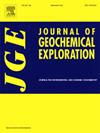A geospatial analysis of coal mine overburden reclamation: Land use, carbon stock, biomass, and soil genesis in chronosequence plantations
IF 3.4
2区 地球科学
Q1 GEOCHEMISTRY & GEOPHYSICS
引用次数: 0
Abstract
Coal remains a pivotal energy source, meeting 27 % of global energy demand and 70 % of India's energy requirements. However, coal mining significantly disrupts land use, necessitating effective reclamation strategies. This study examines the repercussions of coal mining on land use disruption and assesses the benefits of revegetation on structural attributes, biomass, carbon sequestration, and soil restoration in central India. Utilizing Landsat 9 satellite imagery, we characterized land use and vegetation dynamics, employing the Normalized Difference Vegetation Index (NDVI) to classify five distinct age sequence classes with median ages of 5, 10, 20, 30, and 40 years. Results indicated a decrease in tree density from 1408 to 588 trees per hectare as plantations aged from 5 to 40 years, while the basal area increased from 5.88 to 28.25 m2 per hectare. Notably, values in 40-year-old stands approached those of natural forests. Key novelties include the identification of a strong correlation between spectral vegetation indices (SVIs) and soil quality indicators, providing a remote-sensing-based framework for monitoring ecological restoration. Both total standing biomass and carbon stock exhibited significant (p ≤ 0.05) increases with plantation age, ranging from 10.25 to 66.41 Mg ha−1 and 5.16 to 32.74 Mg ha−1, respectively. Soil carbon content decreased with depth, with values ranging from 7.68 to 18.98 Mg ha−1 at 0–20 cm depth, and soil nitrogen values spanning 82.66 to 216.08 kg ha−1. These findings underscore the necessity of site-specific management strategies that integrate technological, ecological, and economic considerations to advance ecological restoration and align with the Sustainable Development Goals by 2030.
煤矿覆土复垦的地理空间分析:时序种植园的土地利用、碳储量、生物量和土壤成因
煤炭仍然是关键的能源来源,满足了全球27%的能源需求和印度70%的能源需求。然而,煤矿开采严重扰乱了土地利用,因此需要有效的复垦战略。本研究考察了煤炭开采对印度中部土地利用中断的影响,并评估了植被恢复对结构属性、生物量、碳固存和土壤恢复的好处。利用Landsat 9卫星影像,利用归一化植被指数(NDVI)对土地利用和植被动态特征进行了分析,并将5、10、20、30和40年的中位数年龄划分为5个不同的年龄序列。结果表明,林龄5 ~ 40年时,林分密度从1408棵/公顷减少到588棵/公顷,而基材面积从5.88 m2 /公顷增加到28.25 m2 /公顷。值得注意的是,40年林龄林分的价值接近天然林。关键的创新包括光谱植被指数(SVIs)与土壤质量指标之间的强相关性,为监测生态恢复提供了基于遥感的框架。随着人工林年龄的增长,林分总生物量和碳储量均显著增加(p≤0.05),分别为10.25 ~ 66.41 Mg ha−1和5.16 ~ 32.74 Mg ha−1。土壤碳含量随深度降低,在0 ~ 20 cm深度为7.68 ~ 18.98 Mg ha−1,土壤氮含量为82.66 ~ 216.08 kg ha−1。这些研究结果强调了针对特定地点的管理策略的必要性,该策略应综合考虑技术、生态和经济因素,以推进生态恢复,并与2030年可持续发展目标保持一致。
本文章由计算机程序翻译,如有差异,请以英文原文为准。
求助全文
约1分钟内获得全文
求助全文
来源期刊

Journal of Geochemical Exploration
地学-地球化学与地球物理
CiteScore
7.40
自引率
7.70%
发文量
148
审稿时长
8.1 months
期刊介绍:
Journal of Geochemical Exploration is mostly dedicated to publication of original studies in exploration and environmental geochemistry and related topics.
Contributions considered of prevalent interest for the journal include researches based on the application of innovative methods to:
define the genesis and the evolution of mineral deposits including transfer of elements in large-scale mineralized areas.
analyze complex systems at the boundaries between bio-geochemistry, metal transport and mineral accumulation.
evaluate effects of historical mining activities on the surface environment.
trace pollutant sources and define their fate and transport models in the near-surface and surface environments involving solid, fluid and aerial matrices.
assess and quantify natural and technogenic radioactivity in the environment.
determine geochemical anomalies and set baseline reference values using compositional data analysis, multivariate statistics and geo-spatial analysis.
assess the impacts of anthropogenic contamination on ecosystems and human health at local and regional scale to prioritize and classify risks through deterministic and stochastic approaches.
Papers dedicated to the presentation of newly developed methods in analytical geochemistry to be applied in the field or in laboratory are also within the topics of interest for the journal.
 求助内容:
求助内容: 应助结果提醒方式:
应助结果提醒方式:


